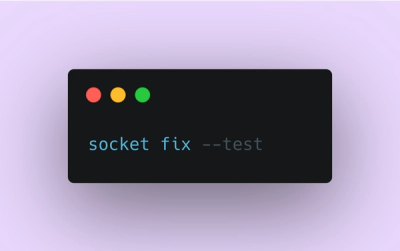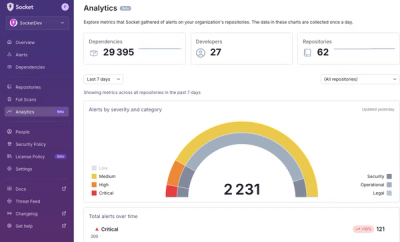
Product
Introducing Socket Fix for Safe, Automated Dependency Upgrades
Automatically fix and test dependency updates with socket fix—a new CLI tool that turns CVE alerts into safe, automated upgrades.
angular2-template-loader
Advanced tools
Angular2 webpack loader that inlines your angular2 templates and stylesheets into angular components.
Chain-to loader for webpack that inlines all html and style's in angular2 components.
Install the webpack loader from npm.
npm install angular2-template-loader --save-devChain the angular2-template-loader to your currently used typescript loader.
loaders: ['awesome-typescript-loader', 'angular2-template-loader'],
To be able to use the template loader you must have a loader registered, which can handle .html and .css files.
The most recommended loader is
raw-loader
This loader allows you to decouple templates from the component file and maintain AoT compilation. This is particularly useful when building complex components that have large templates.
Here is an example markup of the webpack.config.js, which chains the angular2-template-loader to the tsloader
module: {
loaders: [
{
test: /\.ts$/,
loaders: ['awesome-typescript-loader', 'angular2-template-loader?keepUrl=true'],
exclude: [/\.(spec|e2e)\.ts$/]
},
/* Embed files. */
{
test: /\.(html|css)$/,
loader: 'raw-loader',
exclude: /\.async\.(html|css)$/
},
/* Async loading. */
{
test: /\.async\.(html|css)$/,
loaders: ['file?name=[name].[hash].[ext]', 'extract']
}
]
}
@Component({
selector: 'awesome-button',
template: require('./button.template.html'),
styles: [require('./button.style.css')]
})
export class AwesomeButtonComponent { }
The angular2-template-loader searches for templateUrl and styleUrls declarations inside of the Angular 2 Component metadata and replaces the paths with the corresponding require statement.
If keepUrl=true is added to the loader's query string, templateUrl and styleUrls will not be replaced by template and style respectively so you can use a loader like file-loader.
The generated require statements will be handled by the given loader for .html and .js files.
In some cases the webpack compilation will fail due to unknown require statements in the source.
This is caused by the way the template loader works.
The Typescript transpiler doesn't have any typings for the
requiremethod, which was generated by the loader.
We recommend the installation of type defintions, which contain a declaration of the require method.
FAQs
Angular2 webpack loader that inlines your angular2 templates and stylesheets into angular components.
The npm package angular2-template-loader receives a total of 35,396 weekly downloads. As such, angular2-template-loader popularity was classified as popular.
We found that angular2-template-loader demonstrated a not healthy version release cadence and project activity because the last version was released a year ago. It has 1 open source maintainer collaborating on the project.
Did you know?

Socket for GitHub automatically highlights issues in each pull request and monitors the health of all your open source dependencies. Discover the contents of your packages and block harmful activity before you install or update your dependencies.

Product
Automatically fix and test dependency updates with socket fix—a new CLI tool that turns CVE alerts into safe, automated upgrades.

Security News
CISA denies CVE funding issues amid backlash over a new CVE foundation formed by board members, raising concerns about transparency and program governance.

Product
We’re excited to announce a powerful new capability in Socket: historical data and enhanced analytics.